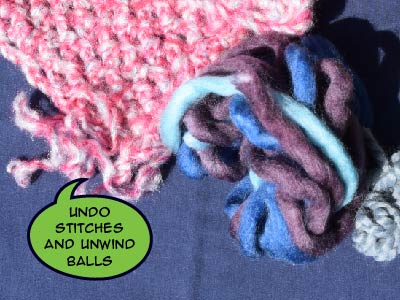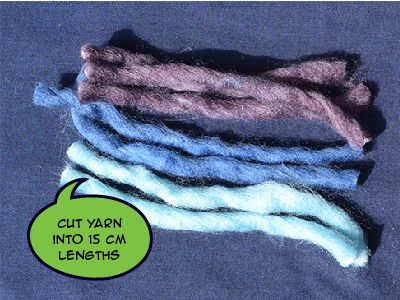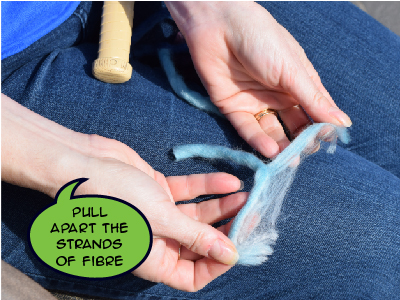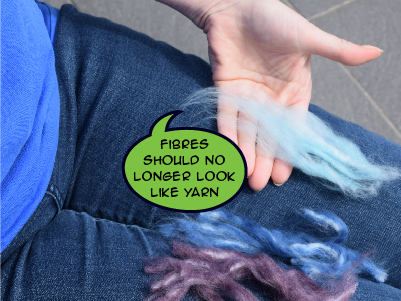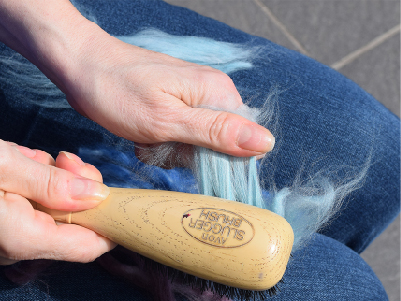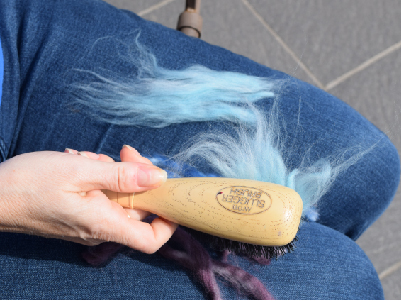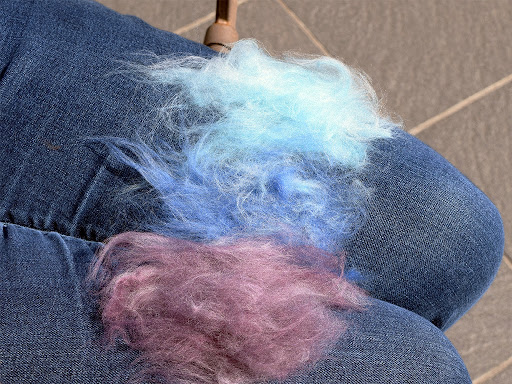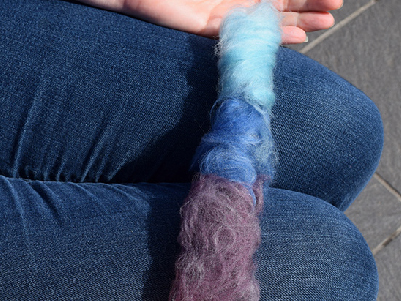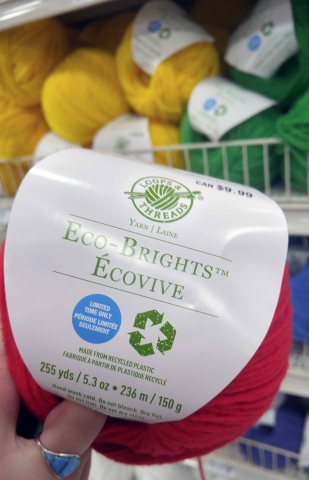
Recycling Yarn Part 1: Preparing the Fibres
Duration
10 minutes (may take longer depending on how much yarn you have).
What You Need
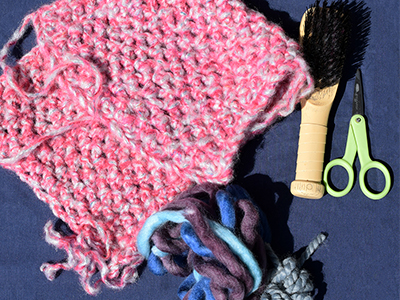
- Scrap yarn.
- Chunky yarns work best, but other types could be used, this could be yarn from an old garment, such as a sweater or a pair of socks or scraps from other projects
- Pair of scissors
- Stiff-bristle hair brush or dog brush
Get Inspired!
Get inspired by these people who are also recycling fibres!
Recycling fashion: The town turning waste into clothes (2020) by BBC News (3:52 min.).
What To Do
Learn More
Yarn is a long continuous length of interlocked fibres. By pulling the yarn apart, you are taking the fibres back to the state they were in before they were made into yarn.
Fibres that come from plants and animals, such wool, apaca, cotton, and linen, are relatively short. They are a lot like the fibres you made. They also tend to be kinky, much like curly hair. You can see this in the closeup of the thread made of wool below. Each of the little hair-like strands is a fibre of wool.
The shape of these fibres lets them hook onto each other. This is why they are good for making yarn.
However, most of the yarns we use are not made from natural sources. They are often made from synthetic materials such as polyester, polypropylene, and acrylic. These yarns are not made from short fibres. Instead we make these yarns by twisting together long filaments of the material. The material is first melted into a liquid. The filaments are then made by pushing this liquid through narrow tubes. These tubes are called spinnerets. When the liquid cools, it forms a thread. Synthetic threads are more durable than threads made from natural fibres.
Did you know?
The word “spinneret” comes from the silk-spinning organ of a spider or insect.
Synthetic fibres can be made in any colour. They can also be stretchy, and can be designed to have other characteristics that people want. Most synthetic fibres are very long, which is why the yarn was cut in this activity. Other synthetic yarns are made from short fibres. This is so that they feel and act more like yarns made from natural fibres.
What's happening?
Yarn is a long continuous length of interlocked fibres. By pulling the yarn apart, you are taking the fibres back to the state they were in before they were made into yarn.
Fibres that come from plants and animals, such wool, apaca, cotton, and linen, are relatively short. They are a lot like the fibres you made. They also tend to be kinky, much like curly hair. You can see this in the closeup of the thread made of wool below. Each of the little hair-like strands is a fibre of wool.
The shape of these fibres lets them hook onto each other. This is why they are good for making yarn.
However, most of the yarns we use are not made from natural sources. They are often made from synthetic materials such as polyester, polypropylene, and acrylic. These yarns are not made from short fibres. Instead we make these yarns by twisting together long filaments of the material. The material is first melted into a liquid. The filaments are then made by pushing this liquid through narrow tubes. These tubes are called spinnerets. When the liquid cools, it forms a thread. Synthetic threads are more durable than threads made from natural fibres.
Did you know?
The word “spinneret” comes from the silk-spinning organ of a spider or insect.
Synthetic fibres can be made in any colour. They can also be stretchy, and can be designed to have other characteristics that people want. Most synthetic fibres are very long, which is why the yarn was cut in this activity. Other synthetic yarns are made from short fibres. This is so that they feel and act more like yarns made from natural fibres.
It is not uncommon for knit garments to get holes in them. These holes can often be repaired by someone who knows about knitting. But for those who do not, the garment will likely be thrown away. Instead of ending up in a landfill, the fibres from these garments can be recycled. Whole new garments and other things can be made from them!
Some companies are creating businesses around doing just that. For example, Loops & Threads® yarns are partly made from recycled plastic.
You can read about other companies in this article about Clothing and Textile Recycling startups.
Why does it matter?
It is not uncommon for knit garments to get holes in them. These holes can often be repaired by someone who knows about knitting. But for those who do not, the garment will likely be thrown away. Instead of ending up in a landfill, the fibres from these garments can be recycled. Whole new garments and other things can be made from them!
Some companies are creating businesses around doing just that. For example, Loops & Threads® yarns are partly made from recycled plastic.
You can read about other companies in this article about Clothing and Textile Recycling startups.
- Unply a longer piece of yarn. Are the fibres made from long single filaments, or short filaments?
- Make your own blend of yarn by using fibres from a variety of yarns. Swap some with a friend to make a custom blend that you can share.
- Try brushing out different types of yarns. Which is easiest to work with?
- Thick chunks of fibre like the ones made here can add interesting texture to weaving projects.
- It is also possible to donate leftover yarn. Find out which charities or organizations near you will accept yarn.
Investigate Further
- Unply a longer piece of yarn. Are the fibres made from long single filaments, or short filaments?
- Make your own blend of yarn by using fibres from a variety of yarns. Swap some with a friend to make a custom blend that you can share.
- Try brushing out different types of yarns. Which is easiest to work with?
- Thick chunks of fibre like the ones made here can add interesting texture to weaving projects.
- It is also possible to donate leftover yarn. Find out which charities or organizations near you will accept yarn.
In this video (4:14 min.), see how to recycle fibres from yarn scraps into stuffing you can use for other projects.
- How to unravel a sweater (2017)
In this video (7:44 min.) learn how to unravel a sweater so that you can use the yarn later.
- Your Yarns: Spin Scrap Yarn (2018)
Get some inspiration for cool yarns spun from recycled scrap yarns.
This article, from How Products are Made, is about how yarns are made.
Web Links
In this video (4:14 min.), see how to recycle fibres from yarn scraps into stuffing you can use for other projects.
- How to unravel a sweater (2017)
In this video (7:44 min.) learn how to unravel a sweater so that you can use the yarn later.
- Your Yarns: Spin Scrap Yarn (2018)
Get some inspiration for cool yarns spun from recycled scrap yarns.
This article, from How Products are Made, is about how yarns are made.
